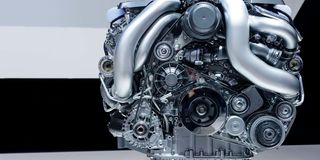Premium
Is it necessary to leave the engine running to “cool down” after a long journey?

If a cooling system works properly, it will maintain the same temperature whether the journey lasts less than an hour or takes all day.
Two weeks ago, Gavin dispelled the long-running myth that the best way to “warm up” an engine is to leave it idling for a few minutes. This week, is it necessary to leave the engine running to “cool down” after a long journey?
Is leaving an engine running for some minutes necessary after a long journey? It is common practice with long-distance vehicles like buses and lorries. What is the purpose? Keep up your good work.
--Nicholas Murithi
I am a relatively new 4x4 driver and a few friends have told me that, especially for turbo diesel engines, it is necessary to let the car idle for a short time after a long journey.
Any thoughts on this? Thanks for the interesting articles.
--Chris Muthuri

Turbo timer.
Dear Gavin, Thanks for your very informative weekly write-ups. I've heard that diesel engines should be left running for a few minutes after a long journey to allow them to cool down a bit before switching off the engine. Some people fit 'turbo timers' to ensure this 'cooling-off' happens even when the driver switches off too quickly. I recently bought a 2016 Toyota Hilux 2.8 diesel double cab. When I stop in traffic, the engine goes off and starts again once I release the brake. This happens even after the engine has been running for hours, which raises the question whether the engine needs to cool down after a long time running. Perhaps 'modern' turbo diesel engines don't need to cool down, or was this just a myth in the first place?
--Timothy Kimathi

Turbo
Short answer: In normal use, engines do not need to be kept idling for a cool-down period at the end of a journey. That applies whether the journey is short or long, moderate or quite strenuous.
Turbos do need a gradual cool-down if they have been working hard, either through gentler driving over the last few minutes of a journey or allowing the engine to idle for some time when the journey ends.
Turbo timers are gadgets that automatically ensure this cool-down period, by keeping the engine idling for a pre-selectable time even if the driver (who may not know, or not remember, or might be in a hurry) switches off the ignition key as soon as the vehicle stops.
Longer answer: It is important to make a clear distinction between the engine itself and the turbocharger which might be attached to it. They are connected and work together, but some of their materials, their running speeds and their operating temperatures are very different.
Engines reach their normal operating temperature within a few minutes of the start of a journey. If their cooling systems are working properly, they will maintain the same temperature whether the journey then lasts less than an hour or takes all day. At normal temperatures, they will suffer no ill-effects by being turned off as soon as the car stops.
By the time the vehicle has come to a halt the engine speed has already slowed to idle (so no sudden inertial jolt when turned off) and promptly switching off carries no risk of thermal shock (even if you stopped in a swimming pool full of ice cubes). The engine components, lubrication and cooling systems are all in their comfort zone throughout.
Turbos are a different matter.
Their turbines spin up to 30 times (!) faster than the engine, and are thus necessarily use some lighter materials. They are “powered” by very hot exhaust gases and can get red hot. When an engine stops moving turbos are still spinning and need continuing lubrication as they spool down. They get that lubrication only when the car’s engine is running. If that oil circulation stops too soon, the residual heat in the turbines can burn the oil that remains in the turbo casing, not only increasing spool-down wear but also clogging vital oil channels.
Idling the engine prevents that and the temperature of exhaust gases drops, too. Nevertheless, turbos are not fit-and-forget items and should be regularly serviced.
Most turbo timers have a selectable range of delay periods, usually between 30 seconds and two minutes, which drivers can pre-select (and change) depending on their likely driving patterns.
The potential for turbo damage from instant switch-off is not a myth. When turbos were first introduced in the Kenya market (especially on commercial pick-ups not driven by their owners) motor agents had a stream of turbo warranty claims. When turbo timers were then fitted, the claims stopped.
In parallel, it should be stressed that the dire consequences of premature switch-off apply when the turbo has been working especially hard before coming to a rapid halt. If the vehicle has been driven moderately, and the final few hundred metres of its journey have been covered at low revs, the driver has already allowed the turbo to cool down and slow down to some extent before stopping, and a switch-off without delay is not likely to do immediate harm. That’s the likely main reason that cars with automatic traffic-stop switch-offs are not in jeopardy.
There are several different explanations for why a truck driver might leave his engine idling, including banal reasons like a dud battery or faulty starter motor, or using the engine to power some auxiliary equipment (eg pumps for tipper hydraulics or air brakes or items in a sleeper cabin). Trucks with big hit-and-miss engines and heavy flywheels idle at lower revs (about 200 rpm) so are relatively less thirsty at idle than cars, which mostly idle at 800 rpm or more.
In sum, it is not the length of a journey but the severity of engine revs that matters.
And it is turbos, not the engine itself, that warrant an idling period before switch-off.
If engine temperature varies, it will not depend on the length of the journey, but on how hard the engine has had to work – mainly the engine revs level (speed and gears), with the effect made greater or less by the load (weight and terrain), the ambient air temperature (weather), and the efficiency of the cooling system (water pump, coolant level, cleanliness of water channels and radiator fins, and the radiator fan and thermostat operations).
Picture puzzle and the real Saab 96

Saab96
Dear Gavin, I like reading your articles in the Wednesday Nation. Your piece on two-stroke engines taught me something new. I was never aware that two-stroke engines can even operate upside down because they don't rely on gravity to recover circulated oil. It was also interesting that you mentioned the Trabant 601. This car with a 600 cc two-stroke engine was produced in East Germany (GDR) by the State-owned company Sachsenring in Zwickau. At the end of production in 1990, the time of the German Reunification, the Trabant was offered a four-stroke VW Polo engine. The aerodynamic Saab 96, which had quite some success in the early Safari Rally, was also fitted with a two-stroke engine of about 800 cc until the mid-90s. Keep up your good work and amazing articles.
-- Peter Herrmann

Saab Rally
Thank you for this additional input, and for kindly overlooking a bizarre mix-up with the pictures that accompanied the two-stroke article. The cause of that is outside my purview, but your note offers an opportunity to now print the right picture to salute the extraordinary Saab 96.
In addition to its competitive performance with such a small engine, the bodywork was also extremely light and tough —which, if I recall correctly, the burly Erik Carlsson demonstrated when the press asked how he kept going even after rolling on a rally stage (in days when rally cars did not have roll bars).
He and his navigator manually rolled the car onto its roof and then back onto its wheels in the car park at rally headquarters. “Like that”, he said. I’m not sure whether he left the engine running.
What’s normal speed, fuel use when engines get older?

Car engine.
Dear Gavin,
Thank you so much for your enlightenment on motor vehicles. I believe we drivers are the great beneficiaries while the dishonest mechanic in the yard is the loser. I bought a 1999 Land Cruiser Prado – an automatic with a 3.0 turbo diesel engine. Consumption around town is 6 km per litre; on highways is 7 to 8 km per litre. Is that the standard consumption of this car? The best speed I can do is 110 maximum. Not much problem with that. My steering is heavy. Please advise what I should check.
--Samuel K
I happen to have the same model as Prado (1998, with 300,000 kms on the clock) so can share some comparisons. My average consumption is about 8 kpl in a mix of conditions. I can get a bit better than 10 kpl if trying to drive especially economically and go as low as 6 kpl if heavily laden in difficult terrain (for example on an off-road safari). Your max speed is surprisingly low. At their advanced ages and mileages, our engines are some way past their peak – slightly less acceleration, not so much torque climbing hills, and perhaps a slight reduction in top speed. But still no smoke and no oil consumption! When I last tested the speed measure some years ago, the answer on a long, smooth flat road with no traffic was 170 kph. I suspect it is a bit less now…perhaps 15 percent down, but not 35 percent!
Every moving part in a vehicle’s drive-train suffers progressive wear over long-term use, with fractional piece-by-piece loss of peak efficiency and cumulative reduction in performance.
Do you know when the timing belt was last changed? That “precautionary” renewal is recommended every 150,000 kms. If your car is using a bit of oil and perhaps blowing some grey smoke, do a compression test to see if the piston rings are worn or if a valve is not sealing properly. If it makes some black smoke, have the injectors been serviced? The performance will also be reduced during hard use if the intercooler is not functioning properly. It may need internal cleaning. Turbos are powered by exhaust gas, but that is not what they pump into the engine. The turbine sucks in “fresh” air and compresses it to increase the density of oxygen and hence increase engine power. But compression itself generates heat and makes air less dense, so is more effective if it is cooled down between the turbo and the engine. The intercooler does that.
There are several possible causes of heavy power steering – such as old or insufficient ATF oil, a tired or damaged pump, or an incipient fault (pressure leak?) in the steering rack mechanicals or hydraulics.





